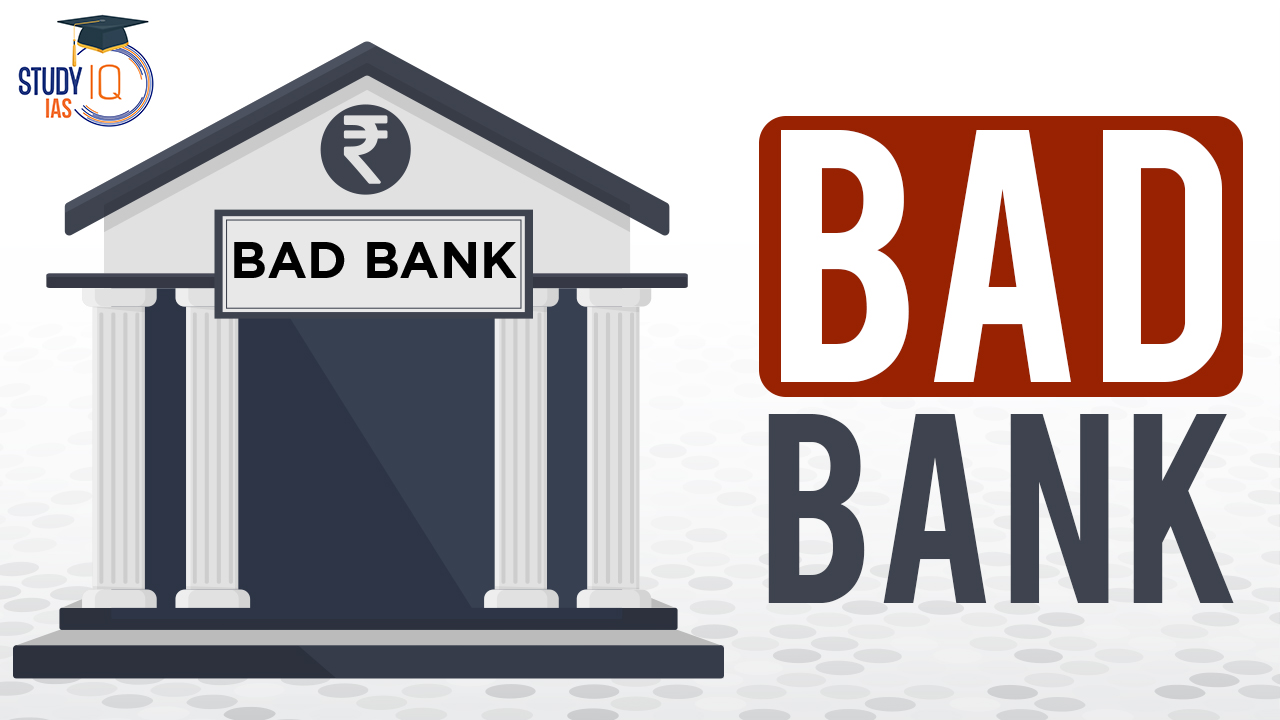Table of Contents
Bad Bank
A bad bank is a financial institution that is specifically created to address the issue of non-performing assets (NPAs) or bad loans held by commercial banks. The primary goal of a bad bank is to relieve the burden on commercial banks by purchasing their bad loans and removing them from their balance sheets. By doing so, the bad bank aims to enable commercial banks to resume lending to customers without constraints.
When a bad bank purchases a bad loan from a commercial bank, it takes on the responsibility of managing that loan. The bad bank may attempt to restructure the loan in order to improve its value or sell it to investors who are interested in acquiring distressed assets.
While a bad bank can generate profits through the sale of these bad loans at a price higher than its acquisition cost, profit generation is not typically the main objective. The primary purpose of a bad bank is to alleviate the burden on commercial banks by allowing them to offload their stressed assets, which enables them to actively engage in lending again.
Read about: Non-Performing Assets
How does Bad Banks work?
A bad bank operates by segregating a bank’s assets into good assets and toxic assets, with the latter being classified as bad or non-performing loans. Good assets are those in which loans are being repaid as scheduled, while toxic assets refer to loans that have defaulted or are at risk of defaulting.
The bad bank is established with the primary objective of aiding in the recovery of these risky assets. It allows commercial banks to remove toxic assets from their books, thereby cleaning up and reducing their exposure to such assets. This process helps banks to improve their financial position and focus on their core lending activities.
Once the toxic assets are identified, they are transferred from the commercial banks to the bad bank. The bad bank assumes the responsibility of managing these assets, which may involve various strategies to recover their value. This could include restructuring the loans, renegotiating terms with borrowers, or selling the assets to interested investors.
When the bad bank acquires toxic assets, it typically does so at a price below its book value. This discount reflects the distressed nature of these assets and compensates the bad bank for the associated risks. The bad bank then aims to recover as much value as possible from these assets over time.
The recovery process may involve actively working with borrowers to rehabilitate their loans, seeking legal remedies for loan defaulters, or exploring opportunities to sell the assets to interested parties. The bad bank’s ultimate goal is to maximize the recovery of funds and, if possible, generate profits by selling the toxic assets at a price higher than the acquisition cost.
By transferring the toxic assets to the bad bank, commercial banks can focus on their core business of lending and financial intermediation, as they are no longer burdened by the management of distressed loans. The bad bank takes on the specialized task of dealing with these assets, facilitating the cleanup of the banking system and promoting the flow of credit in the economy.
Read about: India Post Payment Bank
Bad Bank in India
The Indian government has proposed the creation of a bad bank called the National Asset Reconstruction Company Limited (NARCL) or “Bad Bank” to tackle the issue of bad loans in the banking system. The proposed NARCL aims to acquire and manage stressed assets from public sector banks and facilitate their resolution. It is important to note that the establishment and implementation of the bad bank in India may have progressed since my knowledge cutoff date, so it is advisable to refer to the latest updates and developments in this regard.
Read about: Micro ATMs
Examples of Bad Bank
Here are a few examples of bad banks that have been established in various countries:
| NAMA (National Asset Management Agency) | Ireland’s bad bank created in 2009 to manage and sell off toxic assets from the country’s troubled banks. |
| FMS (Federal Ministry of Finance’s Financial Market Stabilization Agency) | Germany’s bad bank established in 2008 to absorb toxic assets from banks during the financial crisis. |
| RTC (Resolution Trust Corporation) | A U.S. government-owned asset management company created in the 1990s to address the savings and loan crisis. |
| AMCON (Asset Management Corporation of Nigeria) | Nigeria’s bad bank was established in 2010 to resolve non-performing loans in the banking sector. |
Read about: MCLR Marginal Cost of Funds Based Lending Rate
Pros of a Bad Bank
Consolidation
A bad bank can consolidate all bad loans from various banks into a single entity, simplifying the management and resolution of these troubled assets.
International Precedence
The concept of a bad bank has been successfully implemented in countries like the United States, Germany, Japan, and others during financial crises. Learning from their experiences can provide valuable insights for establishing an effective bad bank.
Capital Liberation
By removing bad loans from the balance sheets of struggling banks, a bad bank can unlock significant amounts of capital that were previously tied up as provisions against these loans. This freed-up capital can be utilized by banks to extend new loans and stimulate lending activities.
Capital Buffer Enhancement
A well-designed bad bank can enhance the capital buffers of banks, not by simply shoring up reserves, but by freeing up capital. This can instil confidence in banks, encouraging them to actively engage in lending once again.
Read about: Reserve Bank of India
Cons of a Bad Bank
Government Ownership Shifting
If a bad bank is government-backed, transferring bad assets from government-owned public sector banks to another government-owned entity may not effectively resolve the bad loan crisis. Merely shifting assets between different government pockets may not address the underlying issues and incentives that contribute to the problem.
Ownership Dynamics
Public sector banks, managed by bureaucrats, may lack the same financial incentives and commitment to profitability as private banks owned by individuals. A bad bank bailout does not directly address the root problems of inefficiencies and governance issues within public sector banks.
Moral Hazard Risk
Banks that are bailed out by a bad bank may have limited motivation to improve their lending practices. The safety net provided by a bad bank can potentially incentivize reckless lending behaviour, exacerbating the bad loan crisis in the long run.
Read about: National Payments Corporation of India
Bad Bank Concept Way forward
Moving forward, it is important to recognize that while a bad bank can be a valuable solution, addressing the root causes of the banking system’s structural problems is crucial. One of the key challenges lies in ensuring that the management of public sector banks is not influenced by politicians and bureaucrats, allowing for greater professionalism and adherence to prudential lending norms.
Therefore, alongside the establishment of a bad bank, it is imperative to implement comprehensive reforms aimed at addressing the underlying issues in the banking sector. These reforms should focus on enhancing corporate governance, promoting autonomy in decision-making, and reducing political interference in the functioning of banks.
Additionally, improving the professionalism of bank management through targeted training and recruitment processes can help foster a culture of sound risk management and responsible lending practices. This can be achieved by attracting skilled professionals who possess the necessary expertise and commitment to ensure the profitability and stability of banks.
Furthermore, regulatory reforms should be introduced to strengthen prudential norms, enhance risk assessment capabilities, and ensure effective oversight of the banking system. This will help prevent the recurrence of bad loans and promote a healthier lending environment.
Read about: Difference Between Organised and Unorganised Sector
Bad Bank Concept UPSC
The topic of bad banks is important for the UPSC (Union Public Service Commission) examination as it is relevant to several areas of the UPSC Syllabus, such as economics, banking, and governance. Understanding the concept of bad banks, their pros and cons, and their role in resolving the issue of bad loans in the banking sector is essential for candidates preparing for the UPSC examination. To excel in the examination, candidates can make use of UPSC Online Coaching and practice with UPSC Mock Test to strengthen their knowledge and analytical skills in this topic and its broader context.
Read about: Payment Banks


 Purchasing Power Parity Index, How to Ca...
Purchasing Power Parity Index, How to Ca...
 Unemployment Rate in India, Current Rate...
Unemployment Rate in India, Current Rate...
 RBI Monetary Policy Committee: Repo Rate...
RBI Monetary Policy Committee: Repo Rate...

























